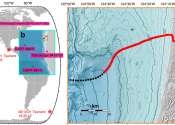Engineers teach AI to navigate ocean with minimal energy
Engineers at Caltech, ETH Zurich, and Harvard are developing an artificial intelligence (AI) that will allow autonomous drones to use ocean currents to aid their navigation, rather than fighting their way through them.
Dec 8, 2021
0
97









